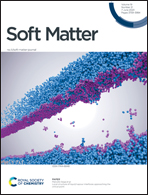Miscibility and exchange chemical potential of ring polymers in symmetric ring–ring blends†
Abstract
Generally, differences of polymer topologies may affect polymer miscibility even with the same repeated units. In this study, the topological effect of ring polymers on miscibility was investigated by comparing symmetric ring–ring and linear–linear polymer blends. To elucidate the topological effect of ring polymers on mixing free energy, the exchange chemical potential of binary blends was numerically evaluated as a function of composition ϕ by performing semi-grand canonical Monte Carlo and molecular dynamics simulations of a bead–spring model. For ring–ring blends, an effective miscibility parameter was evaluated by comparing the exchange chemical potential with that of the Flory–Huggins model for linear–linear polymer blends. It was confirmed that in the mixed states satisfying χN > 0, ring–ring blends are more miscible and stable than the linear–linear blends with the same molecular weight. Furthermore, we investigated finite molecular weight dependence on the miscibility parameter, which reflected the statistical probability of interchain interactions in the blends. The simulation results revealed that the molecular weight dependence on the miscibility parameter was smaller in ring–ring blends. The effect of the ring polymers on miscibility was verified to be consistent with the change in the interchain radial distribution function. In ring–ring blends, it was indicated that the topology affected miscibility by reducing the effect of the direct interaction between the components of the blends.



 Please wait while we load your content...
Please wait while we load your content...